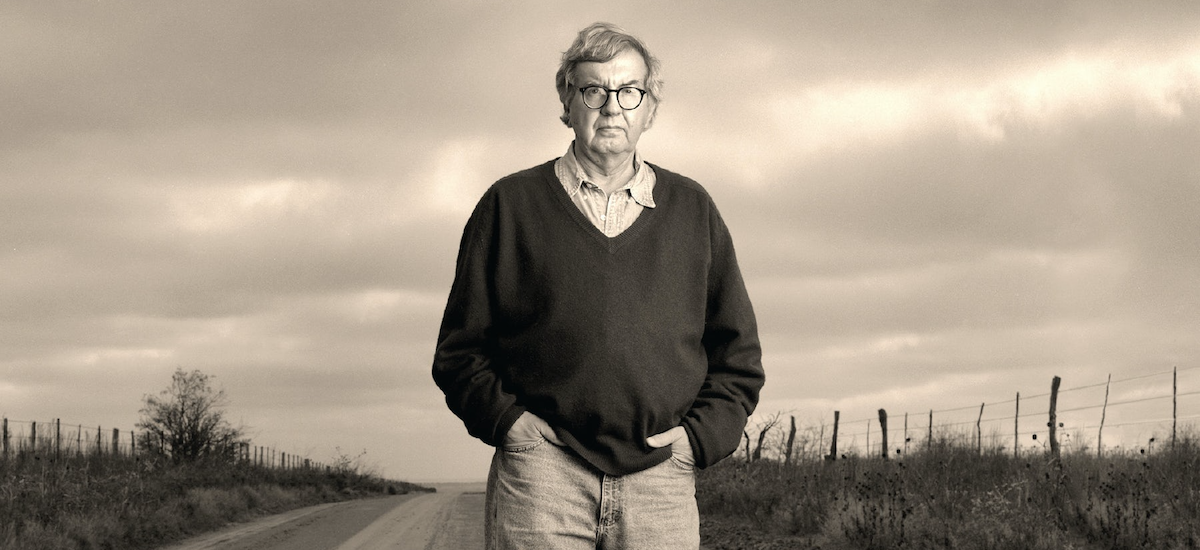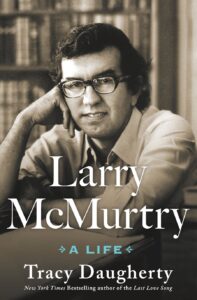
Art Imitates Life: On the Making of Larry McMurtry, The Writer
Tracy Daugherty on the Chronicler of the American West
In October 1958, Larry McMurtry had completed drafts of two full novels, Horseman, Pass By and a manuscript he called Memories of the Old Tribe, later to be revised and titled Leaving Cheyenne. Both novels were elegies for the cattleman’s lost way of life, Horseman culminating in the death of an old cowboy after his cows are slaughtered following an outbreak of hoof-and-mouth disease, and Leaving Cheyenne tracing the lifelong friendship of a Quixote-Sancho pair, both in love with the same woman, both struggling to find their place in a changing world. It was while finishing the draft of Horseman, Pass By that he’d begun sketching the new story, and then he just kept writing each day, five pages every morning, a habit he would continue for most of the rest of his life (on the ranch he’d gotten used to rising early). The fresh pages accumulated to seed his second novel.
Writing was the one thing in his life he was not ambivalent about. At a certain point, in his mid-thirties, that would change, but for now, he was twenty-two, he had kicked out two novels—a process over which he maintained complete control, one of its chief pleasures—and he was living the highly specialized life of a graduate student, spending his days and nights in libraries and bookstores, his mind often in another century. In spite of his love of learning, he knew he was not a scholar—his reading proclivities were too eclectic to be channeled into a narrow academic discipline, and most often now his studies served as craft lessons for his own scribbles. His lack of a scholarly pedigree made him ambivalent about grad school; it was a splendid way to stall for time before entering a professional track, but what was he preparing for? Teaching? Already he suspected he was not cut out for that. If every student was as needy as he was, the responsibilities would be too great to bear. His doubts led to ambivalent friendships—his companions were serious academics or, as in the case of a fierce, fiery fellow from Louisiana named Bill Corrington, a self-professed poet and novelist, they felt a need to compete with him for literary fame. For a while, McMurtry’s closest friends in Houston were a couple named Ray and Linda Waddington. They lived in a trailer home camp on South Main near Rice. Ray had earned his BA at Stanford and was now working on a graduate degree, specializing in the aesthetics of seventeenth-century Platonic poets. McMurtry invited the couple to his parents’ ranch, where Hazel introduced Ray to pecan pie. “She was very friendly, but we didn’t see much of Larry’s father. I got the impression that the younger brother, Charlie, was anxious to get Larry out of the way because he wanted to inherit the ranch someday,” Ray said.
McMurtry studied Ray closely, to observe the scholarly demeanor, to see how it fit (or didn’t) in the world, to extrapolate from his friend’s plans and dreams what it might be like to follow an academic path. (Ray Waddington would eventually wind up teaching Renaissance literature at the University of Wisconsin and then at UC Davis.) McMurtry watched Linda because he found her very attractive, both physically and temperamentally. (Linda’s wits were as quick as Jo’s, but she was far more relaxed.) She was the roundest person he had ever known—round shoulders, round face, round hips. She was beautiful even when pregnant—she gave birth to two boys in rather quick succession.
To some extent, it was the distance and the longing he loved; they were what he’d grown up with.
McMurtry had noticed how the older academic wives at Rice exhibited remarkable patience and calm. These seemed to be emotional requirements of the role, in what was a rather sedate and decorative life. He was curious to see how, or even if, the necessary qualities would develop in a young woman as vibrant as Linda, who was not without patience, but who also enjoyed a good bit of fun. He watched her, thinking of Jo, with whom he was still discussing marriage. Could Jo settle into academic domesticity? (Of course Jo herself was talking about becoming an academic.)
Ray and Linda told McMurtry about the bohemian lives of the students they’d known in California, on the street where they lived, Perry Lane. Some of their friends practiced what they called open relationships, scoffing at the notion of traditional marriage, with its exclusivity and possessiveness. A far cry from Eros as it was pursued, or purported to be, in Archer County, much less on Idiot Ridge.
An Oregon boy named Ken Kesey had just moved into the house the Waddingtons had vacated on Perry Lane when they came to Houston. They’d heard he was a crazy man. He claimed he would be America’s next great novelist.
McMurtry went often with friends to the River Oaks Theater. Watching movies with pals like the Waddingtons was like reading books with a crowd—he didn’t go just to be entertained, but to analyze the films’ narrative structures, to try to understand what formal decisions, made by the director and the editors, gave the story lines the power they had. The River Oaks became another library.
McMurtry saw South Pacific and took wry delight in singing for his friends a song from its soundtrack, “Some Enchanted Evening,” on Houston’s broiling nights. He saw Richard Brooks’s adaptation of Tennessee Williams’s Cat on a Hot Tin Roof. The film starred Paul Newman and Elizabeth Taylor. The story, involving a close male friendship (minus the homosexual overtones, in Brooks’s watered-down version) made turbulent by a volatile woman, bore similarities to McMurtry’s evolving Memories of the Old Tribe. It impressed him that Newman was almost as eye-catching as his costar, though McMurtry thought Elizabeth Taylor “as beautiful as any woman on the planet.” Even more intriguing to him were the stories he had read about her. She had saved Montgomery Clift’s life one night following a terrible car accident by running into the road and pulling broken teeth out of his throat so he wouldn’t choke. Clearly, the woman had a great capacity for friendship; this humanized her, brought her down off the imposing screen. Like millions of other moviegoers, McMurtry fantasized about getting to know her. Unlike millions of others, he would eventually meet her—and he’d spend time with Paul Newman even sooner than that.
On the weekends he drove to Denton to visit Jo. Back in Houston, during the week, he attended classes and frequented bookstores, as well as the Goodwill shop on Washington Avenue and a place called Trash and Treasure on Westheimer, which sometimes tucked quality books among its ripped and yellowed paperbacks.
He immersed himself in the novel, from Samuel Richardson to Anthony Powell. He bought books to improve his education as well as to satisfy his growing collector’s urge. He rekindled his interest in the pulps, recalling the sexy paperback covers in Mr. Wilson’s five-and-dime. He recognized that the covers “were the advance guard of the rapid breakdown of sexual restraint among the middle classes almost everywhere.” As such, they were historical documents. Cultural markers. (The Lady Chatterley’s Lover obscenity trial in Britain, in which Lawrence’s novel was found not to be pornographic, was only two years away.) Too, the pulps were valuable for being descendants of the nineteenth-century dime novels, so essential to selling the romance of the Old West.
He also knew the value of erotica. Beyond whatever prurient pleasure he may have taken from nude photographs, he’d learned that wealthy collectors were willing to pay huge sums of money for them. Like dime novels, pulps, comic books, and bandes dessinées (The Adventures of Tintin—Le Temple du Soleil!), certain erotic series were likely to increase in price in years to come. He was an early collector of the Betty Page bondage photographs taken by Irving and Paula Klaw, a Brooklyn brother-and-sister team largely responsible for introducing S and M into the American mainstream when their bookstore began to fail and they turned to other opportunities. For a while, they sold pinup photographs of movie stars and bathing beauties—the pictures moved much better than rare books and first editions. Then, Paula said, customer demand “brought us that particular interest—bondage, girlie stuff, garter belts and high heels. They were mostly wealthy lawyers and doctors. A couple of them offered to put up the money for the project—models, photography and all, providing we kept their names anonymous…and that’s why and how we did it…We hired the models and the studios and these guys showed us exactly what they wanted done. They taught us.”
McMurtry also collected the fetishistic illustrations and strip cartoons of Eric Stanton, intricate offshoots of the Mickey Spillane covers featuring dominant women and subservient men. For Irving Klaw, Stanton developed the comic series Battling Women and Fighting Femmes. Like the Spillane books and the Betty Page pictures, Stanton’s drawings helped lift kink out of the shadows. Eventually, Betty Page would pose for Playboy (itself an avenue for casual sex into the mainstream) and Stanton would wind up working with Steve Ditko, later a Marvel Comics artist and co-creator of Spider-Man. High and low aesthetics were beginning to blur—a hallmark of what some culture critics would soon be calling postmodernism. Though these same critics would never consider McMurtry anything other than a strict traditionalist, his interest in literary genres and esoteric items made him aware of trends—and of culture’s porousness—far earlier than most observers of the time. He grasped the long ties between soft-core smut sold in small-town dime stores, nineteenth-century erotic doggerel from England, and Pietro Aretino’s Sonetti lussuriosi, a book published in Venice in 1527 featuring sixteen woodcuts by the artist Giulio Romano, illustrating unusual sexual positions.
“The time may have come to part or marry, but, for myself, I put no trust in either alternative. Parting would not leave me free, nor marriage make me happy.” McMurtry wrote these words in 1968, regarding his relationship to the state of Texas, but they could well have expressed his ambivalence about Jo in the fall of 1958. She was finding long-distance dating increasingly unsatisfactory. For him, it was not so bad (and it established a lifelong pattern), putting some distance between him and the object of his affections, necessitating bittersweet longing, letters, and phone calls. To some extent, it was the distance and the longing he loved; they were what he’d grown up with, streaking the Great Plains sky; they supplied the romance behind what was lost before you even had it. He seemed most at home in transit, between commitment and escape, neither denying nor embracing, loving and wanting to be left alone, ticking off another day’s set of miles.
He explored his contradictions in the characters Johnny and Gid at the heart of Leaving Cheyenne: Gid the pragmatic rancher loyal to the land in spite of the hardships it brings him, Johnny the restless cowboy, carefree (or trying hard to be), convinced that richer pastures lie just down the road. For decades, they love and sleep with their friend Molly, though neither settles down with her—she is as restless as Johnny and just as bound as Gid to her lonely oversight of the land. Johnny can romp with Molly and leave in the morning without a second thought, lighthearted and brimming with enjoyment of life; Gid can never spend time in Molly’s bed without a guilty conscience, worrying that sex outside of marriage is wrong, or fearing that his intimacies with Molly amount to a betrayal of Johnny or others or of his duties to the ranch.
In the early 1960s, Ken Kesey read Leaving Cheyenne and suggested to McMurtry that Johnny and Gid represented opposing sides of him. McMurtry replied: “No, I am not quite Johnny and Gid. They lived a dialogue that interested and absorbed me, but I am not really that twosided…I am at least nine/tenths Gid, and have practically no capacity for taking life easy. Though I enjoy my enjoys very intensely.”
In the novel, Molly says of Gid, “He just couldn’t believe sex was right. I don’t guess he left my bedroom five times in his life that he wasn’t ashamed of himself…I had to be careful where I touched him or he would jump like he was electrocuted. But he was the thoughtfulest man I knew, and took the most interest in me. He just wasn’t able to understand that I…wanted him to enjoy himself—he got it in his head, but he never got it in his bones.” And “If I made him sit around and talk when he didn’t want to talk, he would just get self-conscious, and get ashamed of himself, and that would spoil things for him before he ever touched me. The only way…was to keep him from having to face what was on his mind until he was already in the bed. When I could manage that, he loved it…but it was just very seldom that he could let himself go.”
He seemed most at home in transit, between commitment and escape, neither denying nor embracing, loving and wanting to be left alone.
To Kesey, McMurtry wrote: “[I] am not, alas, very seducible. Love lighthearted sex but never begin with it. That is, my body follows my emotions, and seldom precedes them.” In another letter to Kesey written in the mid-1960s, he said: “It may just be that sexual relationships are basically destructive, though I suppose if that were true the world wouldn’t be overpopulated. I agree [that] convention…is inescapable—to escape it you have to set up a counter-convention that traps you and conditions you just as surely as the one you try to escape.”
These melancholy reflections did not encourage a positive approach to marriage. In spite of McMurtry’s protests to Kesey, Leaving Cheyenne did constitute a self-debate. Gid’s father tells him: “If you stay loose from [Molly], she’ll make you the best kind of friend you can have. If you…marry her, you’ll have ninety-nine kinds of misery.” And Molly concludes: “I never had been able to talk [him] out of his conscience”—his inability to “let go”—“or love him out of it, either…[We] were in a situation where neither one of us could completely win.”
Perhaps to test the terms of the debate, McMurtry considered initiating an affair with Linda Waddington. What would a romance feel like in the serious confines of academia, in the context of academic ambition (Linda serving here as a substitute for Jo)? Could he ever learn to temper/change/ live with his conscience? Could the notion of an open relationship, which had clearly intrigued Linda since her Perry Lane days, really be viable? Presumably, McMurtry did not feel the answers would be clear enough in the end, or worth the trouble they’d require. His affair with Linda Waddington remained merely speculative—for now.
In the fall of 1958, the students of Rice Institute produced the first issue of a literary magazine called The Rice Mill. McMurtry published two brief sections of Horseman, Pass By in it—the editor’s note said “the following are two excerpts from a recently completed novel which Mr. McMurtry is now in the process of revising.” He did not receive first billing on the cover. He was named third, after the titles of a scholarly article on Malraux and Nietzsche and a rather pretentious poem, “The Anatomy of Love,” by William Corrington.
If Corrington considered himself the top literary canine on campus, the way Grover Lewis had at North Texas State, McMurtry nevertheless doggedly pressed his case. Earlier, he had sent a slice of Horseman, Pass By to Margaret Hartley, editor of the Southwest Review—it was the scene of the old cattleman’s funeral, which McMurtry intended to be the novel’s first chapter following the advice of his old teacher Martin Shockley. Hartley had responded favorably but just sat on the story, neither publishing it nor accepting McMurtry’s ideas for revisions. Eventually, he wrote to her, asking that Southwest Review relinquish its rights to the story so he could send it to Esquire. Hartley responded curtly, agreeing to release the piece but chastising McMurtry for his poor literary etiquette. Esquire passed.
He then tried a different tack with the Texas Quarterly, a journal under the aegis of the fledgling University of Texas Press. The state of Texas letters, such as it was in 1958, depended almost solely on three men in Austin: J. Frank Dobie, Roy Bedichek, and Walter Prescott Webb, the first Lone Star literary giants, two of whom would soon take notice of McMurtry, and all three of whom McMurtry, in his young-upstart phase (lacking literary etiquette), would take the piss out of in print.
Bedichek had come out of Falls County, Texas, to work as an itinerant reporter and teacher before settling in Austin to head the University Interscholastic League. His lifelong love of camping led him to write a book called Adventures with a Texas Naturalist (1947), establishing him as the state’s foremost essayist. Webb, a farm boy from Panola County, turned his childhood love of stories about the Texas Rangers into a successful career as a historian. In a book called The Great Plains (1931), he speculated that the ninety-eighth meridian, a fault line separating the North American continent’s eastern woodlands from the aridity of the West, stalled westward expansion; not until the technologies of six-shooters, windmills, and barbed wire appeared did America come into its own.
__________________________________

Excerpted from Larry McMurtry: A Life by Tracy Daugherty. Copyright © 2023. Reprinted by permission of St. Martin’s Press, an imprint of Macmillan, Inc.
Tracy Daugherty
Born and raised in Texas, Tracy Daugherty (he/him) is the author of over ten novels and short story collections, a memoir, a book of personal essays, a collection of essays on writing, a novella collection, and several literary biographies. His 2009 biography of Donald Barthelme, Hiding Man, was a New York Times and New Yorker Notable Book, and his 2015 biography of Joan Didion, The Last Love Song was a New York Times Bestseller. His work has been recognized by the Guggenheim Foundation and the National Endowment for the Arts. At Oregon State University he helped found the MFA Program in Creative Writing.












